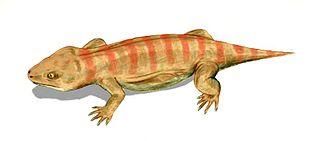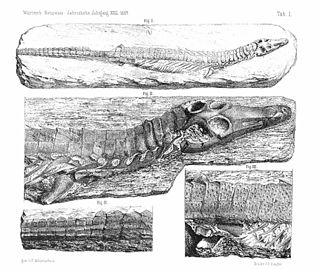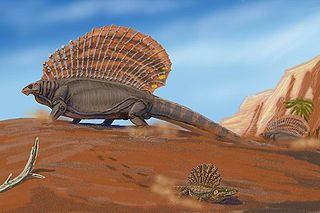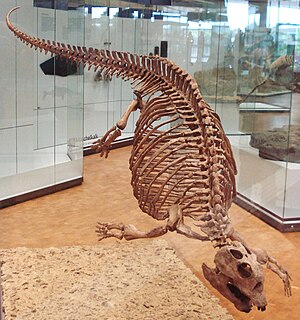
Pterodactylus is an extinct genus of pterosaurs, whose members are popularly known as pterodactyls ( ). It is thought to contain only a single species, Pterodactylus antiquus, the first pterosaur species to be named and identified as a flying reptile.

Rhamphorhynchus is a genus of long-tailed pterosaurs in the Jurassic period. Less specialized than contemporary, short-tailed pterodactyloid pterosaurs such as Pterodactylus, it had a long tail, stiffened with ligaments, which ended in a characteristic diamond-shaped vane. The jaws of Rhamphorhynchus housed needle-like teeth, which were angled forward, with a curved, sharp, beak-like tip lacking teeth, indicating a diet mainly of fish; indeed, fish and cephalopod remains are frequently found in Rhamphorhynchus' abdominal contents, as well as in their coprolites.

Christian Erich Hermann von Meyer, known as Hermann von Meyer, was a German palaeontologist. He was awarded the 1858 Wollaston medal by the Geological Society of London.

Karl Alfred Ritter von Zittel was a German palaeontologist.
Friedrich von Huene, full name Friedrich Richard von Hoinigen was a German paleontologist who renamed more dinosaurs in the early 20th century than anyone else in Europe. He also made key contributions about various Permo-Carboniferous limbed vertebrates.

Batrachomorpha is a name traditionally given to recent and extinct amphibians that are more closely related to modern amphibians than they are to reptiles. It most often includes the extinct groups Temnospondyli and Lepospondyli. The first tetrapods were all amphibians in the physiological sense that they laid their eggs in water, and are colloquially sometimes refereed to as labyrinthodonts or stegocephalians. In this scheme, batrachomorphs composed one branch of these early amphibians, while the reptiliomorphs composed the other. While the actual phylogeny of the modern amphibians is not well understood, their ancestors are descended from one line of batrachomorphs. All other living tetrapods are descended from one branch of reptiliomorphs, the amniotes. Amniotes achieved dominance, while all other reptiliomorphs and most batrachomorphs have gone extinct.

Diplocaulus is an extinct genus of lepospondyl amphibians which lived from the Late Carboniferous to Permian periods of North America and Africa. Diplocaulus are by far the largest and most well-known lepospondyls, characterized by a distinctive boomerang-shaped skull. Remains attributed to Diplocaulus have been found from the Late Permian of Morocco and represent the youngest known occurrence of a lepospondyl.

Metoposaurus meaning "front lizard" is an extinct genus of Stereospondyli temnospondyl amphibian, known from the Late Triassic of Germany, Italy, Poland, and Portugal. This mostly aquatic animal possessed small, weak limbs, sharp teeth, and a large, flat head. This highly flattened creature mainly fed on fish, which it captured with its wide jaws lined with needle-like teeth. Metoposaurus was up to 3 m long and weighed about 450 kg. Many Metoposaurus mass graves have been found, probably from creatures that grouped together in drying pools during drought.

Araeoscelidia or Araeoscelida is a clade of extinct diapsid reptiles superficially resembling lizards, extending from the Late Carboniferous to the Early Permian. The group contains the genera Araeoscelis, Petrolacosaurus, the possibly aquatic Spinoaequalis, and less well-known genera such as Kadaliosaurus and Zarcasaurus. This clade is considered to be the sister group to all later diapsids.

Procolophon is a genus of lizard-like procolophonid reptiles that first appeared in the Late Permian (Lopingian) of South Africa, Brazil, and Antarctica. It persisted through the Permian–Triassic extinction event, but went extinct in the early Triassic. The type species is P. trigoniceps.

Otto Max Johannes Jaekel was a German paleontologist and geologist.
Wann Langston Jr. was an American paleontologist and professor at the University of Texas at Austin.

Josef Felix Pompeckj was a German paleontologist and geologist.

Sclerocephalus is an extinct genus of temnospondyl amphibian from the lowermost Permian of Germany with four valid species, including the type species S. haeuseri. It is one of the most completely preserved and most abundant Palaeozoic tetrapods. Sclerocephalus was once thought to be closely related to eryopoid temnospondyls, but it is now thought to be more closely related to archegosauroids. It is the only genus in the family Sclerocephalidae.

Batropetes is an extinct genus of brachystelechid microbrachomorphs. Although it was first classified as a reptile, Batropetes is now known to be a genus of microsaur amphibians. Batropetes lived during the Sakmarian stage of the Early Permian. Fossils attributable to the type species B. fritschi have been collected from the town of Freital in Saxony, Germany, near the city of Dresden. Additional material has been found from the Saar-Nahe Basin in southwestern Germany and has been assigned to three additional species: B. niederkirchensis, B. palatinus, and B. appelensis.

Dyoplax is an extinct genus of pseudosuchian archosaur. Fossils have been found from the type locality within the upper Schilfsandstein Formation in Stuttgart, Germany. The formation was deposited during the early Carnian stage of the Late Triassic 228 million years ago in a lagoonal paleoenvironment. Numerous bivalves, chondrichthyean fish such as Palaeobates, trematosaurian temnospondyls such as Metoposaurus, a phytosaur, and plants such as Neocalamites and Equisetites were also present in the paleoenvironment that existed at the time. The holotype specimen was a cast of a nearly complete skeleton that lacked only parts of the tail and limb bones.
Procerosuchus is an extinct genus of rauisuchid rauisuchian. Fossils have been collected from the Late Triassic Santa Maria Formation in Geopark of Paleorrota, Rio Grande do Sul, Brazil, which is Carnian in age. The genus was first described by the German paleontologist Friedrich von Huene in 1942.

Paleontology in Oklahoma refers to paleontological research occurring within or conducted by people from the U.S. state of Oklahoma. Oklahoma has a rich fossil record spanning all three eras of the Phanerozoic Eon. Oklahoma is the best source of Pennsylvanian fossils in the United States due to having an exceptionally complete geologic record of the epoch. From the Cambrian to the Devonian, all of Oklahoma was covered by a sea that would come to be home to creatures like brachiopods, bryozoans, graptolites and trilobites. During the Carboniferous, an expanse of coastal deltaic swamps formed in areas of the state where early tetrapods would leave behind footprints that would later fossilize. The sea withdrew altogether during the Permian period. Oklahoma was home a variety of insects as well as early amphibians and reptiles. Oklahoma stayed dry for most of the Mesozoic. During the Late Triassic, carnivorous dinosaurs left behind footprints that would later fossilize. During the Cretaceous, however, the state was mostly covered by the Western Interior Seaway, which was home to huge ammonites and other marine invertebrates. During the Cenozoic, Oklahoma became home to creatures like bison, camels, creodonts, and horses. During the Ice Age, the state was home to mammoths and mastodons. Local Native Americans are known to have used fossils for medicinal purposes. The Jurassic dinosaur Saurophaganax maximus is the Oklahoma state fossil.

Aerodactylus is a dubious pterosaur genus containing a single species, Aerodactylus scolopaciceps, previously regarded as a species of Pterodactylus.

Cricodon is an extinct genus of cynodonts that lived during the Early Triassic and Middle Triassic periods of Africa, approximately 251 million years ago.























